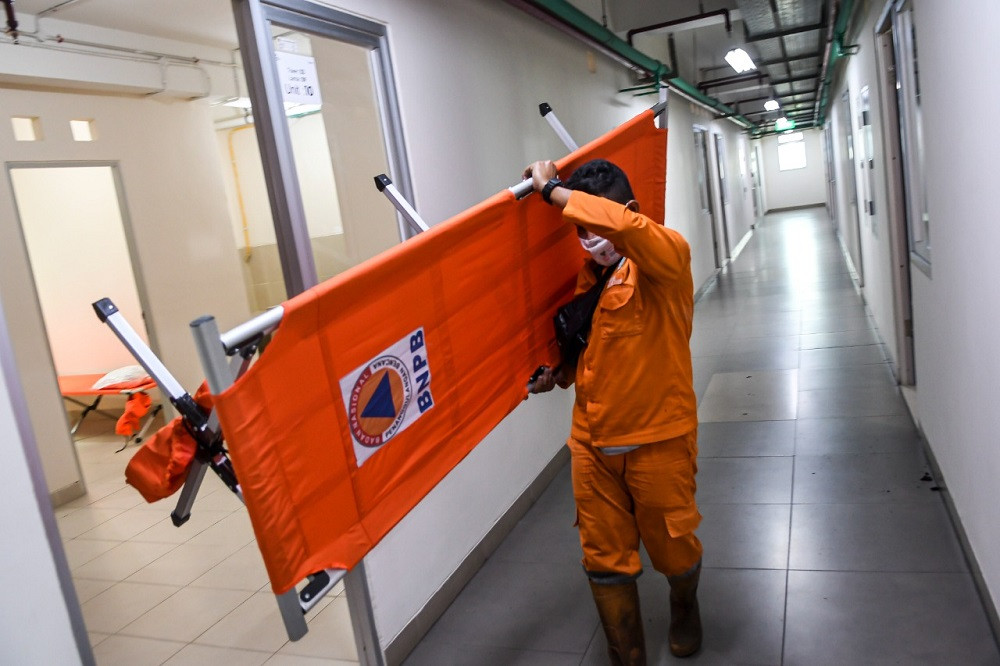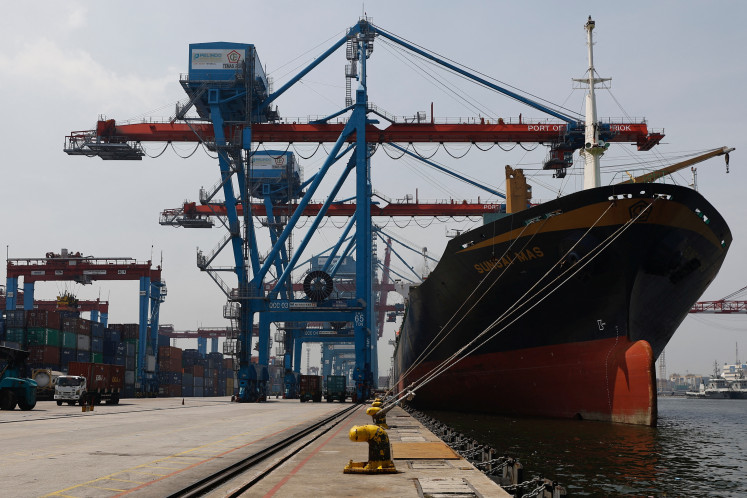Flattening the curve by increasing perceived risk
From the beginning, the risk of infection was especially prevalent in large groups, areas without social distancing, intercity travel (such as in the latest Idul Fitri exodus) and public places.
Change text size
Gift Premium Articles
to Anyone

T
he biggest vaccine rollout in history is underway. In the face of the resurgence in COVID-19 cases, vaccination is one of the best ways to flatten the curve of transmission. Yet, it must be seen how quickly we can move to inoculate 70 percent of the population as needed to achieve herd immunity, and amid the looming threat of new virus variants.
Worldometer data show an upward trend in Indonesia’s number of active COVID-19 cases, from 89,129 cases on May 17 to 101,639 cases on May 30 and then to 115,787 cases on June 15.
To handle this critical stage, President Joko Widodo has instructed that vaccine administration be accelerated to 1 million doses per day. He also asked Jakarta Governor Anies Baswedan to administer 100,000 vaccine doses per day so the capital could achieve herd immunity by the end of August.
At a daily rate of 70,000 jabs, Jakarta has the second highest vaccination rate after Bali. To achieve herd immunity, the nation’s capital needs to vaccinate 7.5 million residents out of its 10 million population (The Jakarta Post, June 15, 2021).
Informing citizens on the vaccine drive is vital to speeding up efforts to achieve herd immunity. The authorities and the public must adhere to the principles of risk management, a useful tool to understand the importance of vaccination and of complying with the health protocols.
Risk management matters in understanding the risks of transmission and emerging variants as vulnerabilities are identified and changes are made to assess the possible outcomes and liabilities. From the beginning, the risk of infection was especially prevalent in large groups, areas without social distancing, intercity travel (such as in the latest Idul Fitri exodus) and public places.
Vaccination is one of two efforts that can facilitate immunity against COVID-19. The other is to limit virus transmission by perceiving the risk more seriously. One of the tools to do this is failure mode and effects analysis (FMEA).
The Jakarta administration has shown quick response and prudent measurements to prevent further outbreaks by intensifying its COVID-19 policies, contact tracing and patient treatment. For instance, it has been able to provide early treatment due to its quick and comprehensive tracing efforts, and it recently doubled the city's testing rate to around 75,000 people per day, almost eight times the World Health Organization (WHO) recommendation.
Traditionally, FMEA is used to quantify risks for user, design and process, to review maximum components and subsystems in identifying potentials that may cause system failure and impacts, especially those with a critical need for change. During the pandemic, applying FMEA can prevent death, reduce medical costs and create anti-failure processes.
FMEA starts with reckoning the risk priority number (RPN), which results from calculating three factors: severity multiplied by probability (likelihood), multiplied by the detectability of a case.
Although other scientists use a scale of 1 to 5 for the RPN factors, many prefer to apply a range of 1 to 10. The higher the RPN, the more important it is to act. Both the severity (S) and probability (P) have a range of 1 to 10, but detection (D), on the other hand, uses an inverted scale of 10 to 1. This is useful for authorities and managers to define the risks in order to determine mitigation efforts, risk tolerance and policy adjustments.
According to Frank Rath from the University of Wisconsin-Madison, who cofounded the Center for the Assessment of Radiological Sciences, an RPN of 125 or higher is problematic in terms of either safety or process capability.
To assist in our understanding, let us take an example. “Mr. A” is an asymptomatic carrier (OTG) who has returned to Jakarta from his hometown, where he attended a family gathering that may have included elderly people and people with comorbidities. Say he has been infected by another OTG during his journey, and has now brought the virus to Jakarta.
During an Idul Fitri get-together in Jakarta, Mr. A transmits the virus to other people. The probability (P) is extremely high at a large gathering that does not observe the health protocols, which increases the level of likelihood of virus transmission. As new variants emerge in the country, the probability also increases, so for our purposes, let us say Mr. A has a probability of 10.
Among the attendees of the Idul Fitri get-together were people with a high mortality rate, such as elderly persons or people with comorbidities, who are more likely to contract COVID-19. This can create the highest severity (S) of 10.
Through investigation and tracing, the authorities detect Mr. A and other OTGs and find that the majority (say, 80-90 percent) test positive for the virus. This means a detection (D) of 1. If the authorities only found that half of these people tested positive, D would be 5. If the authorities failed to detect any of these people, D would be 10.
Let us see how the simulation using these various detection figures (1, 5 and 10) differ. The RPN from Mr. A’s case will show the different degrees of risk the authorities face. If the majority of infected people is detected in surveillance, the RPN will be 100 = 1 (D) x 10 (P) x 10 (S). This indicates that our case has the lowest risk because almost all infected people were detected, so the health authorities can treat them immediately before it gets worse.
When D is 5 with only half of the infected people detected during surveillance, the RPN is 5x10x10 = 500. If none of the infected people are detected during testing and tracing, then D is 10 and the RPN will be 1,000.
As mentioned above, the higher the RPN, the more important it is to act. Low detection indicates nothing negative in the surveillance, provided that the investigation was done carefully.
Severity may be lessened if healthy people have been vaccinated, but we cannot change the severity of transmission among people with comorbidities and other high-risk groups. However, we are able to change their probability and detection through vaccination and applying the health protocols, whereas detection alone can be strengthened by extra surveillance. This is like lowering the risk of home burglary by installing CCTV cameras.
Although we may be content with a lower RPN, we need to remain vigilant.
In managing its COVID-19 outbreak, the Jakarta administration seems to be refraining from complacency. Instead of calming the public, it openly “frightens” the people through strict measures. Since the severity of transmission cannot be manipulated, Jakarta has opted to increase detection so that all stakeholders are seriously aware of the threat while accelerating vaccination.
***
The writer is a medical doctor who teaches at the LSPR Communication & Business Institute, Jakarta.









